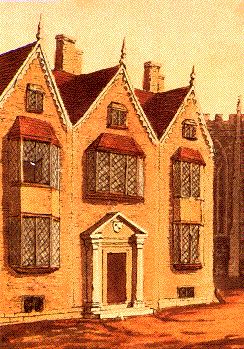A major purchase in Stratford, 1597
At the age of 33, in the year after his son Hamnet died, Shakespeare had enough money to invest 60 pounds in New Place, the second largest house in Stratford, with two barns and two orchards attached. The process of purchasing the house was complicated, however, since there was a scandal to clear up before Shakespeare could take full possession.
William Underhill, from whom Shakespeare bought the house, was poisoned by his son, and Shakespeare had to wait until 1602 before he could finally conclude the deal*.
The expense may have created a problem for Shakespeare, since his name appears later in the same year as a defaulter on the payment of taxes on the fifteenth of November, 1597 -- he owed the sum of five shillings (a quarter of a pound).
Public Record Office, E. 179/146/354. Crown copyright.
This document may be copied and downloaded for personal and
research use only. You must apply to the Public Record Office
for any other use.
In the next year (1 October 1598), he was listed again as being in arrears, this time for thirteen shillings and four pence (two thirds of a pound).
Public Record Office, E. 179/146/354. Crown copyright.
This document may be copied and downloaded for personal and
research use only. You must apply to the Public Record Office
for any other use.
Footnotes
-
A complicated contract
David Kathman untangles the complications that resulted from the scandal:
William Underhill died two months after selling New Place to Shakespeare, and his son Fulke was hanged at Warwick in 1598/9 for poisoning him.The property that Fulke had inherited from his father was thus forfeited to the crown, but it was soon regranted to William Underhill's other son Hercules. Since Shakespeare's purchase of New Place had come so close to William's death, there was apparently some concern over whether New Place was included in the forfeited properties, so when Hercules Underhill came of age in 1602 a second fine [agreement] was drawn up between him and Shakespeare, so that there would be no doubt about the legal ownership.
But Shakespeare appears to have taken physical possession of the house right away, contrary to the implication on your page. In the "Noate of Corn and Malt" drawn up by Richard Quiney on February 4, 1598, William Shakespeare is listed as a resident of the Chapel Street ward. This shows that- Shakespeare was a householder by this time (only householders were included in the "Noate," and Shakespeare had been absent from a similar list made in 1595, since he did not own a house at that time);
- his house was in Chapel Street ward, which is where New Place was located. This is pretty conclusive evidence that, for all practical purposes, William Shakespeare was considered the owner and primary resident of New Place in February 1598, whatever legal quibbles may have remained.


